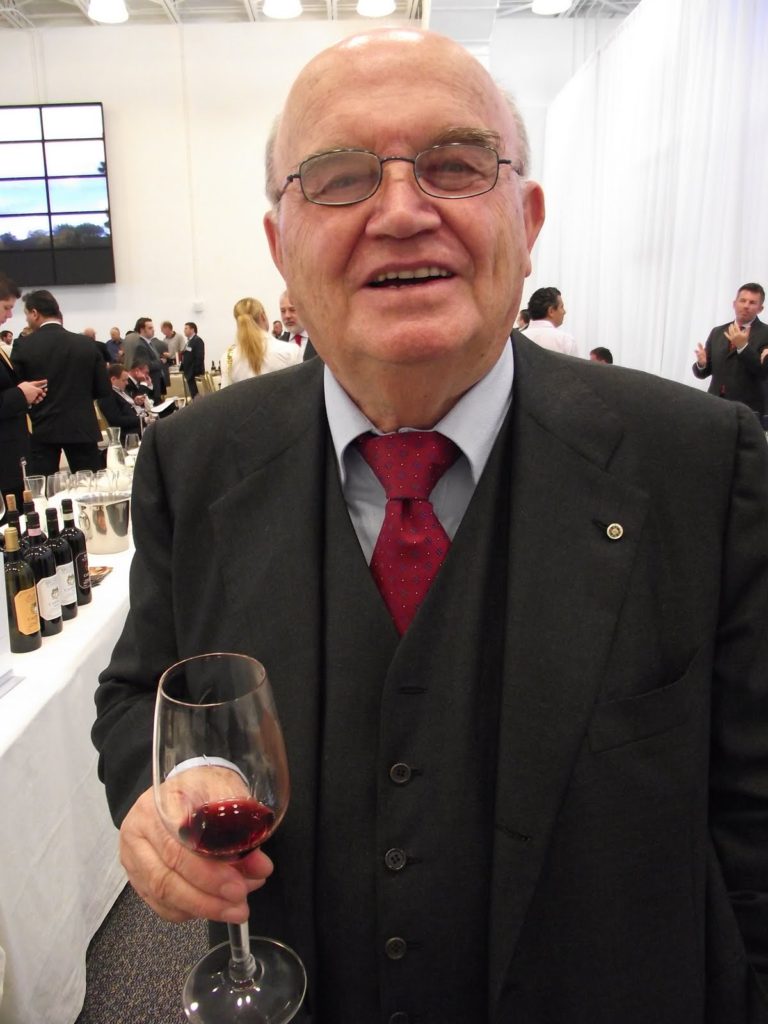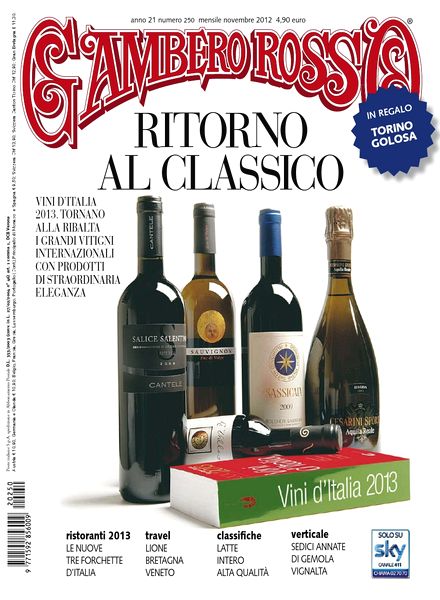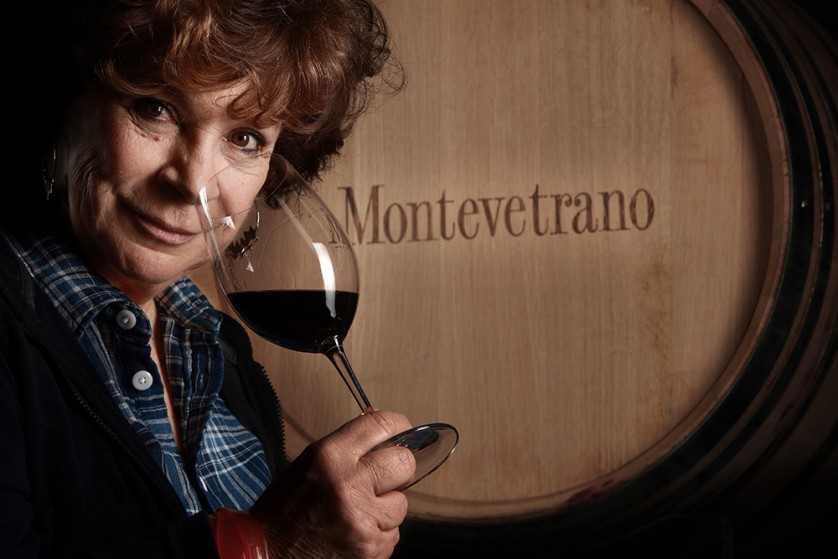Burton Anderson has been called by many, including other world renowned wine experts and journalists, the leading authority on Italian wines. As an established journalist and editor from the Midwest living in Italy for more than four decades, he wrote many important articles and groundbreaking in-depth books on Italian wine. When the Italian wine industry was experiencing a renaissance which was revving up in the 1970s, Burton was right there to write about it and provide a road map for his readers in understanding the vast and confusing subject of Italian wine. No one had achieved this before him. He received critical acclaim for his work and quickly established himself as the most informed writer on Italian wine. The New York Times called his first book, Vino: The Wines & Winemakers of Italy (1980), “the standard reference, in Italian as well as English.” In 1990, his masterpiece, The Wine Atlas of Italy and Traveller’s Guide to the Vineyards, was published. Among other prestigious awards, he received the James Beard Award for Writing on Wine in 1990. In 1994, he completed and published Treasures of the Italian Table. The following year, this book earned him another James Beard Award this time for Writing on Food.
I don’t remember when I first heard about Burton Anderson. But, I do recall that I was still living in Washington, D.C., when I bought a copy of The Wine Atlas of Italy. It was a helpful guide to have with me when I visited the wine regions of Italy while I lived there for seven years. Just a few months after I earned my WSET Diploma in London and a few weeks before I moved back to the United States, I visited him where he lived at the time in Tuscany. I never published this interview because I moved to New York at the end of 2007 to work in the wine industry. So I put my website aside. But I’ve held onto the tapes of this interview. Now, twelve years later, I am publishing my two-hour interview with him in three parts for the first time. In Part One, we discussed his background, career, and writings. In this second installment, we discussed in-depth his thoughts on Italian wine. In the last installment, we finish up talking about Italian wine history and Italian cuisine. Here is Part Two:

* * * * * *
October 18, 2007 – Loro Ciuffenna, Italy
JP: There was a trend in the 1980s and 1990s when Italian wine producers were focusing less on indigenous grapes and more on international grapes like Cabernet Sauvignon, Merlot, and Chardonnay. But now there seems to be a reverse trend of producers returning to making wines with indigenous grapes. What are your thoughts on this?
BA: Yes, I think there is a reverse trend going on. In fact, even in The Wine Atlas, I spoke quite a lot about this. I was a little bit critical about this. At that time, there wasn’t a Cabernet, Merlot, Chardonnay craze. I kept saying to producers who were going that way, you make wonderful Cabernet, Merlot, and Chardonnay, but you’re competing with everybody from around the world. You’re not offering them anything particularly new. In fact, Ezio Rivella, who was head of the Association of Italian Enologists as well as the World Association of Enologists, and I used to have long arguments about this. He said no, you don’t understand anything about marketing – which is true. I said, I don’t know, but Ezio, I’ll make you a bet that in twenty years, people are going be going wild about these obscure Italian varieties because you know as an enologist that there’s going to be an improvement in the quality of them. Things that are just a good, different with a funny name, and something unusual to have with dinner.

This is happening, but it’s slow. I can understand a lot of producers who say to me, well, I just can’t risk going out there with Verdicchio, for example. I’ve always been a fan of Verdicchio. They’re making some wonderful bottles of it that cost six or seven Euros. They’re worth much more than that, but they just can’t promote it. They can’t get out there and sell it. I don’t know why. I think it’s too bad. On the other hand, Nero d’Avola, which fifteen years ago was unknown, is now a big trendy variety. A lot of the southern Italian varieties are coming on.
JP: I’ve been a fan of the Aglianico.
BA: That’s always been one of my favorites.
JP: In those southern regions like Campania, Sicily, Apulia, and Calabria, you can see the pride the producers have for their indigenous grapes.
BA: Like Primitivo di Manduria, for example, is a wonderful wine.
JP: When I’ve talked to producers that I visited in Campania they express frustration that they are not getting much attention internationally.
BA: They’re coming on now. Things like Gambero Rosso, luckily, have started pushing them by giving them high ratings. In fact in Campania, when I was writing The Wine Atlas, that was probably the place I was most critical. I said the only example of what you can do here is Mastroberadino. Everybody else was just slipping off, going to the co-operative, and making shotty wines. I was happy to get my words in because shortly after that, a lot of new young producers started coming on with good wines. Some of them have been more successful than perhaps they deserve to be, but others are just starting to get noticed. In some cases, it’s just small things like working with Aglianico or Greco di Tufo.

JP: I thought for a co-op, Taburno, was making amazing wines.
BA: They’ve improved so much from when I went there. I spent a day with the people there twenty years ago.
JP: Silvia Imperato of Montevetrano wasn’t in Campania yet at that time, of course. But because she’s focusing on Cabernet and having lots of success, there’s a little bit of resentment from other producers in Campania.
BA: Yeah, she’s not too popular with her colleagues.

JP: Are there other Italian grapes that you think will eventually get more attention.
BA: I think for example, starting from the north, Teroldego and Lagrein. They are very close in style. I’m not sure if they’ve DNA’d those two wines and actually made them relatives. I adore those wines. I’ve had something like Pignolo. Of course, Barbera is now recognized, but it was such a rare varietal wine when I started writing. There are things coming up in Tuscany like Colorino. No one thought that would come up as a varietal wine. They’re pretty interesting wines. When you go throughout the country, there are I’d say probably 30 or 40 varieties that have the potential to at least be very good wines – maybe not excellent.
JP: I hope this continues.
BA: I do see this happening now especially after many years of being disappointed that they weren’t getting any attention.
JP: You wrote in Best Italian Wines that because France has been making quality wines so much longer, they have set the standard of what the noble grapes are. The full merits of Italian varietals may not be known until the current research is completed. At this point, where do you think we are in that research process?
BA: That’s one of the most hopeful factors. The reason I’m optimistic is because I know that Sangiovese is not at its maximum. Any enologist who’s been working here for a while, will say we made great improvements over the last ten or fifteen years, but the next ten or fifteen, we’ll make the same kind of improvements. Where’s great Brunello going to end up? Where’s great Gavi going to end up? They’re already in many cases getting the same kind of ratings that Burgundies, Bordeauxs, and California Cabernet are getting. I think the Italian noble varietials are still just getting the attention and selection that the French varieties have gotten over the last 150 years. When they start coming on, I think you’ll see the attention. Not everybody will agree with me about Sangiovese. I’m a Sangiovese freak. I adore it.
JP: The delicate nature of the Sangiovese grape has been compared to the delicate nature of the Pinot Noir grape.
BA: Sometimes it shouldn’t be. To me the great thing about Sangiovese is that it’s so variable. Sure, there’s uniformity of it in a place like Montalcino even though there’s quite a variation from the lower part where Banfi is to the upper part where Biondi-Santi is. Whereas the beauty of Chianti I think is that it’s so varied and each estate, if they work honestly with Sangiovese, can produce wines that have great personality and are very much their own thing.
JP: There is an opinion in the wine world that because of consolidation in several wine regions and because of the influence of the ratings by wine critics, certain styles of wine are becoming homogenized. While that has happened and although it is not the whole story of the wine producing world, do you think this is a danger to be concerned about or do you think that diversity in wine styles is alive and well?
BA: I think even wine critics probably get tired of doing the same thing over and over again. I mean at some point I think somebody like Parker – I don’t want to get into Parker’s psyche because I think it’s quite complicated – he must be saying to himself, you know, in many cases a lot of these wines that I’ve given high ratings to have a uniformity to them. If you can computerize the way – someone wrote a book about this – you can more or less make a wine in California that would get a 94-or-above rating from Parker. This is getting beyond the spirit of making wine. The rating system takes the spirit out of it because it means that 90 and up are wines that people who can afford them are going to buy those wines. Ninety and under, not so much interest unless they are a bargain.
JP: Alternatively, people come over here and meet the wine producer and have a great vacation. That’s going to be a high scoring wine to them.
BA: There’s no getting around it. If you have a certain familiarity with, not only the wine, but also the place and people, you’re going to like that wine more. You’re going to appreciate what’s behind it and it doesn’t necessarily mean something that you can put down on paper and say well, 94, loads of fruit, that kind of thing.
JP: Italian white wines have come a long way. To me, the most impressive white wines in the world are French Chenin Blanc and German Riesling that have the ability to age for years and remain fresh. Do you think there’s an Italian white grape that has that ability to age.
BA: I think that Verdicchio has the potential to stand at the same level, not so much with Riesling because Riesling is more floral. I’ve tasted Verdicchio that go back 20 or 30 years that are still very viable. But the problem is that the people who made these wines have kept them in their cellars except for the possible exception of Ampelio Bucci who has a bit of a reputation for his old Verdicchio. They just don’t have enough confidence in this to make a batch of something that can age. Podium, made by Garofoli which is a commercial firm that buys their grapes, is an excellent wine. If you go back now and taste the 1997, it’s fantastic and getting better. There are some young producers now who are starting to get into this. But it isn’t only a matter of longevity, it’s also a matter of gradually reaching a peak the way a great Chardonnay from Burgundy does at peaking out over say ten, twelve, or fifteen years.

JP: You don’t think that Italian whites have reached that level yet.
BA: No, for the simple reason that they haven’t been working long enough with whites to do that. But I think the Verdicchio has that potential and I’m sure that things like Fiano del Avelino and Greco could. Actually, I’ve been quite impressed with some of the Soaves recently.
JP: Although Italy has a great tradition with dessert wines made with white grapes.
BA: Italy does rightly have a great tradition of dessert wines, but they’re made on a miniscule scale. Like there’s nothing to compare with Sauternes in terms of volume even though once you get past the top ten or fifteen Sauternes, you’re not talking about high quality. Vin Santo is, of course, so varied but there are some great examples of it led by Avignonesi. More and more small wineries are making batches of wine that could be considered as great dessert wines. Sagrantino is another one that may be better and have more potential as a dessert wine than as a dry wine. Recioto di Valpollicella is coming back strong.
JP: The younger generations of winemakers seem to be willing to experiment more than the generation before them. Do you think there is a danger of Italian wines losing their identity as this younger generation moves away from the traditional winemaking methods?
BA: I think we’ve already seen the development of one young generation with the barrique craze when almost anything went into barrique. Some people used it well, a lot of them didn’t. I think at least the most astute of them, the ones that really cared about quality, realized that there’s nothing magic about barrique so long as you know how to use it. Unfortunately, there are still too many people out there who think a dose of oak is a pleasant experience.
Where I do have contact with people who ten or fifteen years ago were using new barrique for everything, they are now holding back and taking a second look and figuring out how they can make wines that are more refined. Paying much more attention to their venue where it all starts. That’s the reason why a lot of these indigenous not-very-well-known varieties have improved so much because they finally realized that you can’t just let them grow. You have to control them to get more concentrated wines.
I think there’s a younger generation and they’re not all so young. I mean a lot of people I would consider younger generation are now at least fifty years old. They are still doing things. They maybe went too far. You see a lot of this, for example, in Barolo where I think they exaggerated for a while, barrique and so on. They are pulling back and making wines that have better balance and more refined although the high alcohol content is still there. Unfortunately, in some cases, to make the kind of wine that’s going to get the attention that it needs, it’s pretty hard to avoid going over fourteen percent in alcohol. That’s true for a lot of varieties. Sangiovese for example.
JP: Yes, I recently found a Primitivo in a wine store in Florence where the alcohol content was sixteen percent.
BA: Primitivo of course is naturally very high in sugar. Sangiovese and Nebbiolo are also high in sugar. Well, there are very few Barolos that are coming out now at least from the more appreciated producers that are under fourteen percent. And even a lot of the top Super Tuscans which are based on Sangiovese are mainly over fourteen. It isn’t necessarily a bad thing even though some people get a shock by the idea of wines that high. You’re also going to see there may be a trend among consumers to look for wine that is a little more refined that isn’t a blockbuster. But maybe that’s wishful thinking.
JP: Regarding Italian wine drinkers, are you noticing a difference in attitudes toward wine between younger Italians and older Italians?
BA: I think there’s been a big change in attitudes. When I first came here, it was literally rosso or bianco in loco. People were partial to their local wines. The wines that people drank in bottle were drunk once a week, once a month, or once a year. Whereas now there has been a tremendous shift – and I give Gambero Rosso and Slow Food a lot of credit. They have done a lot to make Italians aware of this great heritage they have in wine and to appreciate it. Younger people are definitely much more aware of wines now than older generations. I keep running into people who know a hell of a lot more about what’s going on in Italian wine now. They keep track of new estates much more than I do.
JP: Unlike Montalcino with its Brunello, it seems to me that Montepulciano has not grown in the number of producers making a high quality Vino Nobile. It remains to be a place where only a few producers are making really good Vino Nobile. Why do you think that is the case?
BA: I think it’s because the ones who are making the better wines have the best vineyards. Boscarelli which year in and year out have been my favorite with the Il Nocio Vino Nobile is in a very privileged position. Asinone which is Poliziano’s Vino Nobile is also privileged. Avignonesi can make very good Vino Nobile when they put together their blend of the best which they call Grandi Annate. But I think probably Montepulciano doesn’t have that kind of potential that Montalcino has.
JP: When Pinot Grigio exploded, what was your reaction to that?
BA: There are a few good ones. The story of how it happened was when Santa Margherita started going up the cellars in Alto Adige and found this Pinot Grigio, and started bottling it, and it took off. I wrote an article for Wine & Food I believe in 1982. At that time Pinot Grigio was already coming up as one of the styles. I said it was a cocktail wine. A by-the-glass wine to drink at the bar. Not much character nor to be taken seriously to pair with food. It’s still so ridiculously popular.
There are many stories about how much is really Pinot Grigio and how much is some other grapes. I guess they still haven’t been able to analyze the wine to tell whether it’s coming from a certain variety although they will be able to someday. But I just don’t understand it. It’s bland. I find much more interesting Pinot Bianco, for example. You know a lot of people take Pinot Grigio fairly seriously. I guess it’s a light alternative to California Chardonnay. I don’t know. It doesn’t cost much. I just do not understand it. It’s a magic name and it has no reason to be, in my opinion. No right. It doesn’t deserve its reputation. I have tasted a few good ones mainly from Trentino and Friuli. What I like about them is that they have a little character to them. The old type was copper color. When it’s made in that style it can be quite interesting. But it’s bland, low acidity.
*******
Coming Soon: An Interview with Burton Anderson – Part Three, in which we discuss his views on Italian wine history and cuisine.

